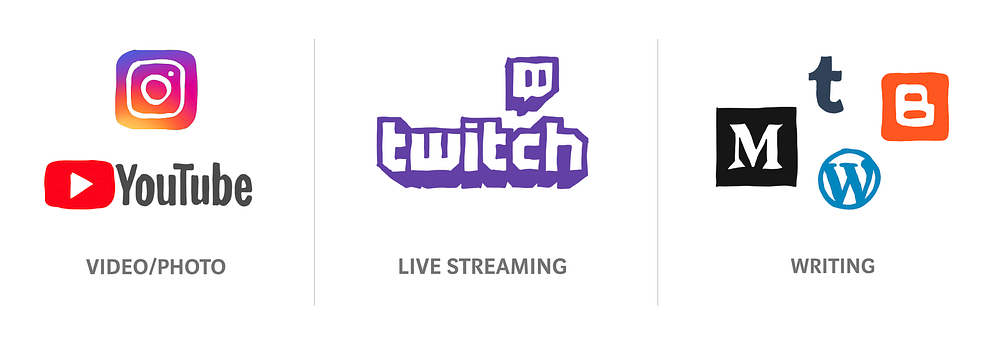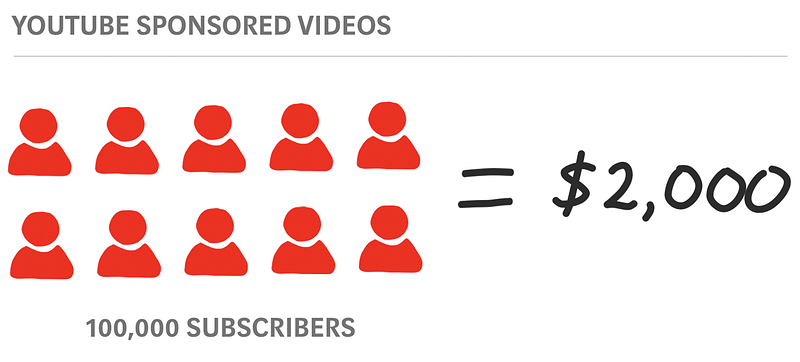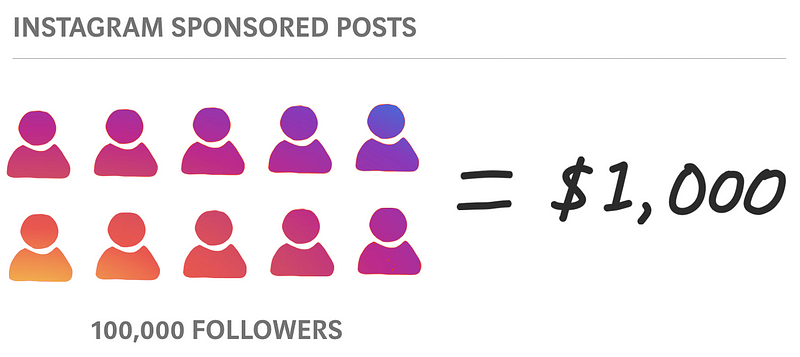And exactly how much you can expect to earn per follower, subscriber, or sponsored post
August 25th. Two twentysomethings enter a ring to settle their differences with a good old-fashioned fistfight. Normally, a public brawl like this might become a spectacle. This year, it made history.
If you’re under the age of 25, you may recognize this event as Logan Paul vs. KSI, an amateur boxing bout between two of YouTube’s biggest stars. The fight garnered over a million viewers on YouTube’s pay-per-view platform and 21,000 live spectators at the Manchester Arena, making it the fourth-most-watched boxing match ever.
Between ticket sales and sponsorship deals, rough estimates put the pair walking away with $50 million each. Not bad for two dudes who, to anyone outside the YouTube bubble, seem to have come out of nowhere.
Of course, it’s actually taken years of dedication for these influencers to make an event like this possible. Logan Paul (24) has been making online videos for the past 14 years; KSI (25) for the past decade.
Deep down, we all want to be influencers — though social media has watered down the word’s meaning, it still taps into something universal. We want people to listen to us and respect us. While Logan Paul and KSI are certainly outliers, achieving “influencer” status in your own niche is pretty doable. Here’s how.
The Journey

Your journey to influence will be paved with money. There are four milestones worth considering:
- Making any money at all: $1 per month
- Making an interesting amount of money: $500 per month
- Making a living: $2,000 per month
- Making a lot of money: $20,000 per month
Depending on your platform, the number of followers you need will differ but the ways to make money are the same:
- Running ads alongside your content
- Sponsorship deals with brands
- Direct donations and subscriptions
- Hawking your own wares
Here’s how many followers you’ll need to hit each milestone:

And here’s what the journey looks like on each platform.
YouTube
The YouTube Partner Program is the platform’s official monetization route. It lets creators run ads on their videos to earn money. You need 1,000 subscribers to be considered for the program.
Once you’re a partner and choose to display ads, you can earn roughly $1 per 1,000 views. With 1,000 subscribers, you might make enough to cover a cup of coffee a week if you post regularly.
To hit $500 per month through ad revenue alone would require roughly 500,000 total video views per month. Posting two new videos a week, you’d need approximately 60,000 views on each. Subscribers don’t directly translate to views, though — you can reasonably expect 20 percent of your subscriber base to watch each of your next videos, so you’d need about 300,000 subscribers to reach this goal. This is a lot, and it typically takes at least a couple of years to reach.
Once you’re a partner and choose to display ads, you can earn roughly $1 per 1,000 views.
Luckily, once you have around 20,000 subscribers, the world of “influencer marketing” starts to open up. Depending on your niche and the personal brand you cultivate, different types of companies may want to work with you.
If your followers are students, you might be offered deals to promote lifestyle items like backpacks or productivity apps. At the bottom end, these deals might involve free products to test and review. At the top end, you’ll get a nice check, too.

With roughly 50,000 subscribers, you can expect to receive $500 to $1,000 to try out a product and talk about it on video.
If you’re lucky, influencer marketing agencies will reach out to you. These deals may fall into your lap. If not, you can sign up for one of an increasing number of influencer marketing platforms — marketplaces that connect influencers with brands.
With a bit of effort and roughly 30,000 followers, influencer marketing will let you hit $500 per month fairly easily. Reaching $2,000 per month is just a matter of gaining more followers. With 100,000 subscribers, you could easily charge $2,000 for a single sponsored video.
$20,000 per month, however, is a different ballgame.
100,000 subscribers might bring you $1,000 per month via ad revenue and $5,000 per month through 2–3 sponsored videos. This sounds promising, but unfortunately sponsored videos don’t scale. Three obviously sponsored videos in a month would definitely be noticed by your followers, and it might taint your relationship with them.
With 500,000 subscribers, you can get to $20,000 per month through ads and the occasional brand deal. If you want to reach this goal sooner, you’ll need to get creative. This typically involves creating a product or service to sell to your followers.
If you’re in a skills-based niche, you can do very well by creating a paid online course for your followers. If not, creating branded merchandise — T-shirts, mugs, hats — works too.
Fitness guru Jeff Cavaliere sells tailored training programs. Fashion vlogger Zoella has her own line of beauty products. Brothers Jake and Logan Paul each have their own clothing brands, as do many other popular vlogging personalities.
Regardless of your niche, one of the quickest and easiest ways to multiply your income is to transfer your existing fanbase to a new — and more lucrative — platform.
Instagram doesn’t have any official monetization features, so any money you make will be through external channels. Securing brand deals is the main way to monetize your Instagram influence. This becomes possible once you hit 5,000 followers.
The payout at 5,000 followers isn’t much — free product samples, or $50 if you’re lucky — but it’s a start.

Instagram is the leading platform for influencer marketing in terms of volume, but market rates are slightly lower than YouTube. Justifiably so — scrolling through an Instagram feed demands less engagement than watching a YouTube video. If you have 100,000 Instagram followers, you can charge approximately $1,000 for a sponsored post.
As a creator, you can get away with posting more sponsored content on Instagram than on YouTube. The “stories” feature lets you create posts that disappear after 24 hours, so there won’t be a permanent record of your #sponcon. Using this together with normal sponsored posts, you can get away with posting twice as much sponsored content on Instagram as on YouTube.
Hitting the $2,000 per month milestone is manageable with 100,000 followers and a few sponsored posts every month.
At 50,000 followers, you might be able to secure deals for around $500 per post if you’re lucky, but closer to 100,000 followers makes it more feasible.
Hitting the $2,000 per month milestone is manageable with 100,000 followers and a few sponsored posts every month.
$20,000 per month, once again, comes down to creating products and services to sell to your followers. That is, unless you’re willing to wait until you have more than 1 million followers—at which point, sponsored posts become much more lucrative.
Twitch
Twitch has made monetization a core focus of its product — unsurprising, given that it was created in 2011, when influencer marketing was beginning to take off. While other platforms are built on interactions between followers and creators, Twitch distinguishes itself by allowing followers to interact with one another via a live chat box. This creates a sense of community that the platform exploits well.
There are a few ways to make money on Twitch, starting with the Affiliate Program. You need only 50 followers to be considered for the program, which gives you access to three of Twitch’s monetization features:
- Direct subscriptions: Followers can give you a monthly subscription fee of $4.99, $9.99, or $24.99 in return for vanity upgrades.
- “Bit” revenue: Followers can support you by spending “Bits” (the platform’s internal currency) to “cheer” you on during your stream.
- Game sales: When followers buy a copy of the game you’re streaming via your page, you receive five percent of the revenue.
These are, in part, acts of performative loyalty. Subscribing early on to an up-and-coming streamer is the new “discovering a band before they were cool.” Your reward on Twitch is a badge of honor in emoji form next to your username. It enables other viewers in the live chat (and the streamer themselves) to see your level of devotion.
At a small scale, direct subscriptions are the most reliable revenue stream. If you’re reasonably entertaining, you can expect roughly 1 percent of your followers to subscribe, so 10,000 followers might make you around $500 monthly. This scales all the way to the top end, albeit with a decrease in the subscriber:follower ratio as your reputation grows. Once again, with a bit of creativity, you can find other ways to monetize your audience.
Ninja, Twitch’s most popular streamer, makes $5 million per year from the platform, $3 million of which is through direct subscriptions.
If you ever make it into the top 1 to 2 percent of streamers, you’ll have the chance to become a Twitch partner. This lets you show ads on your stream. However, with ad-blockers drastically reducing ad impressions, many streamers decide it’s not worth the bother.
Blogging
This is a difficult one to pin down, as there’s no single platform that dominates the blogosphere. Blogs are distributed across personal websites and platforms like Medium and WordPress. The landscape is made even more confusing by the fact that there’s no default way to monetize a blog.
The only real way to make money at small scale is through direct subscriptions. Patreon is the most popular way to facilitate this, though other services are starting to pop up. There’s also a growing movement, championed by groups like Substack, which empowers writers to start charging for their work as early as possible.
How soon you can earn money depends on two things: the niche you’re writing for, and how hard you push for donations or subscriptions. Some writers spend years building an audience before even thinking about money. Others start charging from day one.
“Getting a book deal” is to bloggers what “starting a clothing brand” is to Instagrammers.
Esteemed tech blogger Ben Thompson had a “freemium” model right from the start — one free article every week and a daily post exclusively for paid subscribers. Bill Bishop, a leading voice on China, did the opposite. He wrote for free for six years before going fully paid. Both are now making very comfortable livings, directly supported by their readers.
Alternative paths to make money are beginning to crop up. Medium now has paid memberships that give readers access to stories behind the platform’s metered paywall, and writers earn a cut of the membership fees. The payout varies significantly — the top 50 percent of authors in the Partner Program earn money, with the top 10 percent earning over $100 per month. The top metered story in a given month typically generates $2,000 to $5,000.
For hobbyists, Medium’s solution is a pretty good deal. The recommendation system makes it possible for new writers to get eyes on their work from day one, and earning $500 to $2,000 per month is, with a bit of dedication, achievable. $20,000 per month is currently not — the top-grossing writer in a month makes almost $10,000 — but it’s still early days (Medium began allowing writers to monetize last year).
There’s no playbook to hitting $20,000 monthly by blogging. The subscription model has done it for some — Ben Thompson and Bill Bishop via their sites, and soon Tim Urban via Patreon — but others have to look further afield.
“Getting a book deal” is to bloggers what “starting a clothing brand” is to Instagrammers. Tim Urban gained notoriety through Wait But Why and is now writing a book. Eric Barker of Barking Up The Wrong Tree did the same, and Ben Orlin just released Math With Bad Drawings.
Above a critical mass of popularity, advertising and sponsorships can be similarly lucrative. John Gruber’s Apple blog, Daring Fireball (2.5 million monthly visitors), has a single sponsor each week and generates roughly $35,000 per month. Once again, the niche matters — philosophy blog Slatestar Codex gets one fifth of Daring Fireball’s traffic but only generates one tenth of its income via ads.
Writing is a medium that’s more about the message than the messenger, so the culture around blogs is less accepting of clickbait.
Blog advertising tends to be a bespoke affair. Instead of plugging into major ad networks (Google Ads, Carbon), serious bloggers typically run their own ad programs with a limited number of carefully selected companies. In part, this comes down to economics — Daring Fireball’s income would drop by 80 percent using Google ads.
It’s also a matter of aesthetics. Traditional display ads misalign incentives in favor of clickbait and add visual clutter that pollute the creator’s brand. These problems exist on other platforms too. Compared to video, however, writing is a medium that’s more about the message than the messenger, so the culture around blogs is less accepting of clickbait. Centralized platforms (YouTube, Instagram) also have native ad formats that are less obtrusive than traditional display ads, reducing the issue of clutter.
The subscription model addresses both of these problems and allows a more direct relationship between creators and their audiences, one that isn’t mediated by brands. Paying for online content isn’t yet a social norm, but it’s seen strong early adoption in the blogosphere and is starting to catch on elsewhere — YouTube, for example, rolled out its own subscription productthis year.
Now that you know what to do, it’s time to pick your poison and get to work. Get ready to face your fair share of naysayers, though.
There are definitely problems with the influencer ecosystem, not least its effects on young peoples’ mental health and on influencers themselves. I’m optimistic that we’ll figure these out.
We could dismiss the movement with jeers of “15 minutes of fame” and “famous for being famous.” We shouldn’t.
The Internet has taken power from traditional media gatekeepers. It’s democratized fame, letting anyone achieve celebrity. And in doing so, it has revealed a fundamental human truth: We each have a great deal of value to provide to others. All we need to do is share a part of ourselves with the world.
SOURCE: https://medium.com/s/story/how-to-make-a-living-on-the-internet-959e7a90a69a
Taimur
Data scientist and writer – https://www.taimur.me